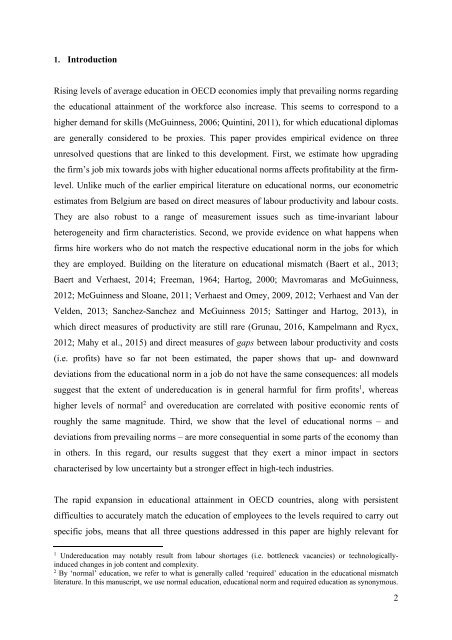CEB Working Paper
240798&r=lma
240798&r=lma
You also want an ePaper? Increase the reach of your titles
YUMPU automatically turns print PDFs into web optimized ePapers that Google loves.
1. Introduction<br />
Rising levels of average education in OECD economies imply that prevailing norms regarding<br />
the educational attainment of the workforce also increase. This seems to correspond to a<br />
higher demand for skills (McGuinness, 2006; Quintini, 2011), for which educational diplomas<br />
are generally considered to be proxies. This paper provides empirical evidence on three<br />
unresolved questions that are linked to this development. First, we estimate how upgrading<br />
the firm’s job mix towards jobs with higher educational norms affects profitability at the firmlevel.<br />
Unlike much of the earlier empirical literature on educational norms, our econometric<br />
estimates from Belgium are based on direct measures of labour productivity and labour costs.<br />
They are also robust to a range of measurement issues such as time-invariant labour<br />
heterogeneity and firm characteristics. Second, we provide evidence on what happens when<br />
firms hire workers who do not match the respective educational norm in the jobs for which<br />
they are employed. Building on the literature on educational mismatch (Baert et al., 2013;<br />
Baert and Verhaest, 2014; Freeman, 1964; Hartog, 2000; Mavromaras and McGuinness,<br />
2012; McGuinness and Sloane, 2011; Verhaest and Omey, 2009, 2012; Verhaest and Van der<br />
Velden, 2013; Sanchez-Sanchez and McGuinness 2015; Sattinger and Hartog, 2013), in<br />
which direct measures of productivity are still rare (Grunau, 2016, Kampelmann and Rycx,<br />
2012; Mahy et al., 2015) and direct measures of gaps between labour productivity and costs<br />
(i.e. profits) have so far not been estimated, the paper shows that up- and downward<br />
deviations from the educational norm in a job do not have the same consequences: all models<br />
suggest that the extent of undereducation is in general harmful for firm profits 1 , whereas<br />
higher levels of normal 2 and overeducation are correlated with positive economic rents of<br />
roughly the same magnitude. Third, we show that the level of educational norms – and<br />
deviations from prevailing norms – are more consequential in some parts of the economy than<br />
in others. In this regard, our results suggest that they exert a minor impact in sectors<br />
characterised by low uncertainty but a stronger effect in high-tech industries.<br />
The rapid expansion in educational attainment in OECD countries, along with persistent<br />
difficulties to accurately match the education of employees to the levels required to carry out<br />
specific jobs, means that all three questions addressed in this paper are highly relevant for<br />
1<br />
Undereducation may notably result from labour shortages (i.e. bottleneck vacancies) or technologicallyinduced<br />
changes in job content and complexity.<br />
2<br />
By ‘normal’ education, we refer to what is generally called ‘required’ education in the educational mismatch<br />
literature. In this manuscript, we use normal education, educational norm and required education as synonymous.<br />
2


